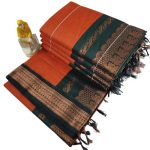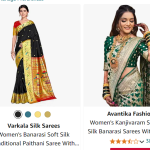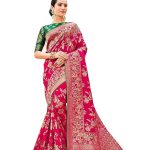Sarees have been a symbol of elegance and tradition for centuries, and the combination of a blue saree with a red border is one of the most classic and vibrant choices. This color combination represents grace and festivity, making it suitable for various occasions such as weddings, festivals, and even casual gatherings. In this guide, we will explore every detail you need to know about the “Blue Saree with Red Border,” from its product details to usage instructions, price variations, and frequently asked questions (FAQs).
Advertisements
Sanskar Traditional Paithani Cotton Silk Sarees With Contrast Blouse Piece (Sky Blue & Red)
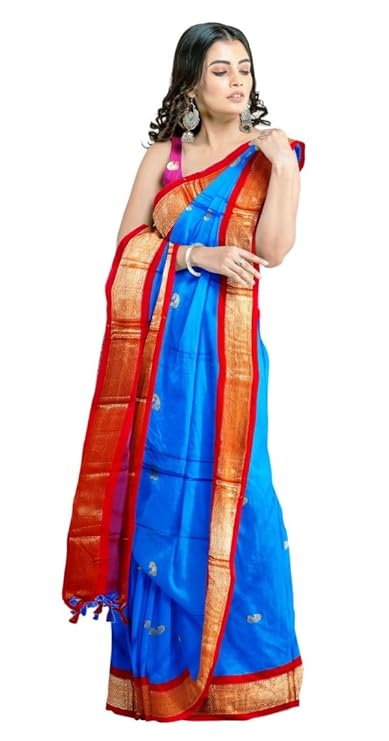
Product details
Material composition : Art Silk
Weave type : Paithani
Occasion type : Festival
Pattern : Embroidered
Included components : With blouse piece
Care instructions : Dry Clean Only
Country of Origin : India
SGF11 Women’s Kanjivaram Soft Lichi Silk Saree With Blouse Piece
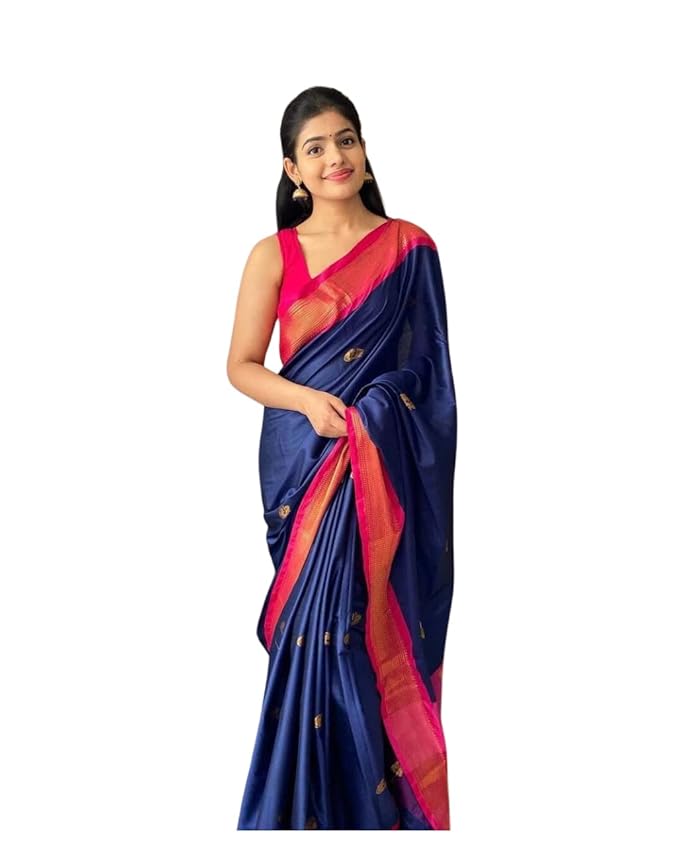
Product details
Material composition : Kanjivaram Soft Silk
Weave type : Kanchipuram
Design name : Zari
Length : 6 yards
Included components : With blouse piece
Care instructions : Dry Clean Only
Country of Origin : India
3Buddy Fashion Women’s Plain Lycra Blend Jacquard Lace Border Saree With Blouse
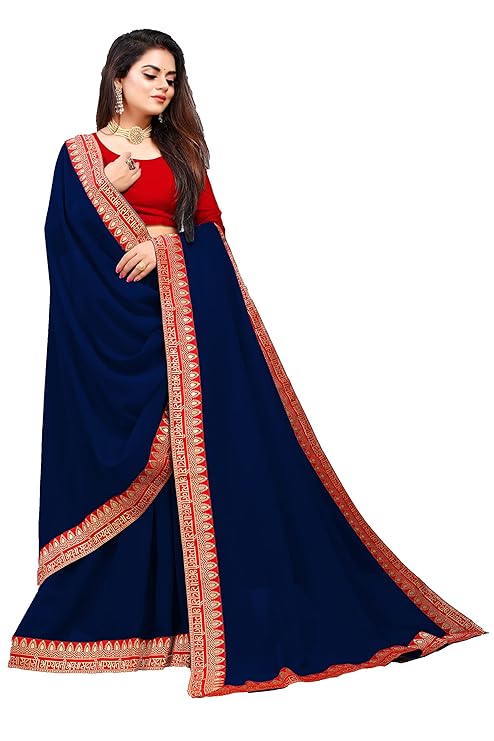
Product details
Material composition : 80% Lycra, 20% Banglory Silk
Weave type : Plain
Design name : Lace
Length : 6 yards
Occasion type : Festival, Party, Wedding
Pattern : Solid
Country of Origin : India
1. Product Details: Blue Saree with Red Border
A blue saree with a red border can come in various fabrics, designs, and patterns. Below are the common types of sarees in this combination, highlighting their unique features:
- Fabric:
Most blue sarees with red borders are available in fabrics like silk, cotton, chiffon, georgette, and satin. Each fabric offers a different level of comfort, style, and occasion suitability.- Silk Sarees: Known for their luxury and richness, silk sarees are perfect for weddings or special events.
- Cotton Sarees: Lightweight and breathable, cotton sarees are best suited for daily wear or casual outings.
- Chiffon/Georgette: These are more fluid fabrics, giving the saree a flowy and modern look.
- Satin Sarees: Shiny and smooth, satin sarees add glamour to any evening event.
- Design:
The red border can vary in design, from intricate gold embroidery to simple plain red. Some borders have zari (gold or silver thread work), while others may include lace or threadwork to add an extra touch of style. - Blouse:
Most sarees come with an attached blouse piece that matches or contrasts with the saree. The blouse can be tailored to different styles such as sleeveless, short-sleeved, or full-sleeved depending on personal preference. - Length and Width:
Typically, sarees are about 5.5 to 6 meters in length and have a width of around 1.15 meters, which is suitable for draping in traditional styles. - Occasions:
This color combination is versatile and can be worn on a variety of occasions, including:- Festivals: Perfect for Diwali, Navratri, or Durga Puja.
- Weddings: The vibrant red border adds a festive touch.
- Office Wear: A cotton version of this saree can be worn for formal office events or daily wear.
2. How to Use the Product Safely
Sarees, especially in delicate fabrics like silk or chiffon, require proper handling and care to ensure longevity. Here are some tips on how to use and maintain a blue saree with a red border safely:
- Washing Instructions:
- Always check the fabric type before washing. Delicate sarees, like silk and chiffon, should be dry cleaned, while cotton sarees can be hand-washed in cold water.
- Avoid using harsh detergents. Opt for mild, fabric-friendly solutions to prevent color fading.
- If hand-washing, gently swirl the saree in water without wringing or scrubbing.
- Ironing Tips:
- Iron the saree at low heat, especially on delicate fabrics like silk. For cotton sarees, you can use medium to high heat.
- To prevent the saree from sticking or burning, iron it on the reverse side.
- For sarees with heavy embroidery on the red border, avoid ironing directly over the embroidered area. Place a thin cotton cloth over it before ironing.
- Storing the Saree:
- Store the saree in a cool, dry place, preferably in a saree cover to prevent dust or insects from damaging the fabric.
- Silk sarees should be wrapped in a muslin cloth to prevent moisture from affecting the fabric.
- Keep the saree away from direct sunlight to avoid color fading, especially on the vibrant red border.
- Draping Safety:
- When draping the saree, be cautious with pins. Avoid pulling or tugging the fabric too tightly to prevent tearing, especially around the red border.
- If the saree has heavy embroidery, make sure to distribute the weight evenly while pleating.
Advertisements
3. Pros and Cons of the Blue Saree with Red Border
Pros:
- Elegant and Versatile: The blue saree with a red border is suitable for various occasions, from casual wear to weddings.
- Timeless Combination: The contrast of blue and red is a classic, never going out of style.
- Available in Various Fabrics: You can choose the fabric that suits your needs, from light cotton for everyday use to luxurious silk for special events.
- Customization: Blouses can be customized in various styles to match your preferences.
- Budget-Friendly Options: Available in a range of price points, making it accessible for different budgets.
Cons:
- Care Requirements: Delicate fabrics like silk or georgette need careful handling and regular dry cleaning.
- Not Ideal for All Body Types: Heavier fabrics like silk may add bulk, which might not be suitable for everyone.
- Limited Use in Extreme Weather: Silk sarees might not be comfortable in hot weather, while cotton sarees might be too light for winter months.
- Occasion-Specific: Heavily embroidered sarees may not be suitable for casual occasions or everyday wear.
4. Price Details of Blue Saree with Red Border from Multiple Countries
Prices for a blue saree with a red border can vary based on fabric, design, and brand. Below is a list of approximate price ranges from various countries:
- India:
- Cotton Sarees: ₹1,000 – ₹3,000
- Silk Sarees: ₹4,000 – ₹15,000
- Georgette/Chiffon Sarees: ₹2,500 – ₹7,000
- United States:
- Cotton Sarees: $25 – $50
- Silk Sarees: $60 – $200
- Georgette/Chiffon Sarees: $40 – $100
- United Kingdom:
- Cotton Sarees: £20 – £40
- Silk Sarees: £50 – £150
- Georgette/Chiffon Sarees: £30 – £80
- Australia:
- Cotton Sarees: AUD 40 – AUD 80
- Silk Sarees: AUD 90 – AUD 250
- Georgette/Chiffon Sarees: AUD 60 – AUD 150
- Canada:
- Cotton Sarees: CAD 30 – CAD 60
- Silk Sarees: CAD 75 – CAD 200
- Georgette/Chiffon Sarees: CAD 50 – CAD 120
The prices listed above are approximations and can vary depending on the brand, design, and quality of the saree.
5. Discount Coupons for Blue Saree with Red Border
When purchasing a blue saree with a red border, it’s essential to keep an eye out for discount coupons or seasonal sales. Some websites and brands may issue coupons, especially during festive seasons or clearance sales. Below are a few places where you might find discount coupons:
- Amazon: Offers discounts on ethnic wear, including sarees, during their yearly sales such as Prime Day, Diwali sales, and other festive occasions.
- Myntra: Popular for ethnic wear, they often have discount codes available during the Big Fashion Sale or festive events like Navratri and Diwali.
- Flipkart: Known for offering great discounts on Indian ethnic wear during sales like the Big Billion Days.
- Ajio: Offers regular coupons and discounts on traditional wear, especially during clearance sales.
To stay updated, always check the website’s offers section or subscribe to newsletters to receive alerts about new discounts or special promotions.
Advertisements
6. FAQs About Blue Saree with Red Border
- What is the most suitable fabric for a blue saree with a red border?
- The best fabric depends on the occasion. Silk sarees are great for weddings, while cotton sarees are suitable for daily wear.
- Can I wear a blue saree with a red border for casual events?
- Yes, cotton or lightweight georgette sarees in this color combination are perfect for casual or office events.
- How should I care for my silk blue saree with a red border?
- Dry clean silk sarees to preserve their shine and color. Store them in a muslin cloth to protect them from moisture.
- Can I wash the saree at home?
- For delicate fabrics like silk, it’s recommended to dry clean. For cotton sarees, you can hand-wash them using cold water and mild detergent.
- Are blue sarees with red borders suitable for all skin tones?
- Yes, the contrast between blue and red complements a wide range of skin tones, making it a versatile choice for everyone.
- What accessories go well with this saree?
- Gold jewelry complements the red border beautifully. You can also wear silver or oxidized jewelry for a more casual look.
- How do I choose the right blouse design?
- The blouse design should match the saree’s occasion. For a festive look, you can opt for a heavily embroidered blouse, while a simple, plain blouse works well for casual wear.


